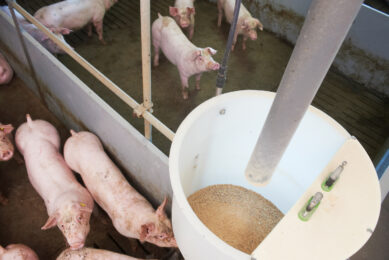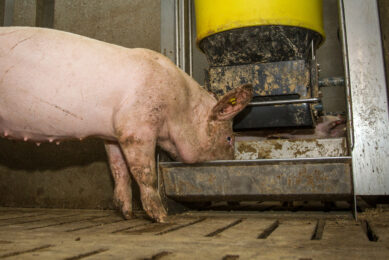Medication via liquid feeds – do we need further controls?
In the UK, our Veterinary Medicines Directorate are planning to restrict the use of medicines – medicated feed premixes and water soluble products – in liquid feeds. These medicines will not be allowed to be added to liquid feeds directly. What is the situation in the rest of Europe, how do you medicate liquid feeds?
In the UK, our Veterinary Medicines Directorate (VMD) are planning to restrict the use of medicines – medicated feed premixes (MFPs) and water soluble products (WSPs) – in liquid feeds. These medicines will not be allowed to be added to liquid feeds directly. What is the situation in the rest of Europe, how do you medicate liquid feeds?
We have been fortunate in the UK to be allowed to medicate feed on farm, as well as via the feed mill and there are a set of regulations and guidelines, which have to be followed. Importantly, farms can be licensed to add prescription-only medicines (POM) such as antimicrobial MFPs and are inspected, to check they comply.
Liquid feeding of pigs has always been an important method of rearing pigs, especially in finishers and also in sows. Approximately, 30% of finishing pigs here are on liquid feed and it is a useful method of disposing of nutritious by-products from the dairy and the brewing industries. Many other countries have much higher percentages of pigs on liquid feed (e.g. Ireland, Denmark) since the introduction of Salmonella monitoring and control. It is a useful way of reducing the incidence, especially, if the feed is fermented or acidified to bring the pH down.
The future plan is that MFPs can be only added to dry feed in the normal way and water soluble products can be added to water, in both cases prior to mixing and distribution to pens in the normal way. For pulse feeding where the mixing with water is in small and regular quantities this is fine. However, when there is a large mixing tank, which is strongly agitated and then the contents are thoroughly mixed and pumped out to the troughs, is there really any need to restrict the addition of the premix or a pre-dissolved soluble formulation directly into the tank?
The consultation document states that it is ‘To ensure that the correct amount of medicine is consumed and that the risks of over-dosing, proliferation of antimicrobial resistance or poor health through under-dosing are minimised.’
In my experience, feed premixes and water solubles have been successfully added to liquid feeds for over 30 years and generally have been a very effective way of administering treatment to finishing pigs. Where there are big tanks, the quantity of medication to be added, calculated on a mg of drug/kg bodyweight basis, gives a far more accurate dose than in feed concentration in parts per million (ppm). Similarly, with soluble products, the dose can be more accurately determined for the group of pigs, where water intake can fluctuate with temperature. Those pigs that are neither drinking nor eating will need an injection if they are going to survive.
If we do medicate liquid feed directly with premixes or water solubles then it is proposed to be under ‘cascade’ and a 28 day withdrawal period should be applied. In the UK, there is only one product formally approved for use in liquid feeds and that is for the treatment of Actinobacillus pleuropneumoniae only. So, if there is an outbreak of dysentery or ileitis towards the end of finishing, one could be in real trouble, as the delay may lead to over-weight pigs.
So what is the situation in other countries? How do you medicate liquid feed? It would be very useful to get some feedback on this – as regulations in one country have a habit of spreading across the rest of the EU.
We have been fortunate in the UK to be allowed to medicate feed on farm, as well as via the feed mill and there are a set of regulations and guidelines, which have to be followed. Importantly, farms can be licensed to add prescription-only medicines (POM) such as antimicrobial MFPs and are inspected, to check they comply.
Liquid feeding of pigs has always been an important method of rearing pigs, especially in finishers and also in sows. Approximately, 30% of finishing pigs here are on liquid feed and it is a useful method of disposing of nutritious by-products from the dairy and the brewing industries. Many other countries have much higher percentages of pigs on liquid feed (e.g. Ireland, Denmark) since the introduction of Salmonella monitoring and control. It is a useful way of reducing the incidence, especially, if the feed is fermented or acidified to bring the pH down.
The future plan is that MFPs can be only added to dry feed in the normal way and water soluble products can be added to water, in both cases prior to mixing and distribution to pens in the normal way. For pulse feeding where the mixing with water is in small and regular quantities this is fine. However, when there is a large mixing tank, which is strongly agitated and then the contents are thoroughly mixed and pumped out to the troughs, is there really any need to restrict the addition of the premix or a pre-dissolved soluble formulation directly into the tank?
The consultation document states that it is ‘To ensure that the correct amount of medicine is consumed and that the risks of over-dosing, proliferation of antimicrobial resistance or poor health through under-dosing are minimised.’
In my experience, feed premixes and water solubles have been successfully added to liquid feeds for over 30 years and generally have been a very effective way of administering treatment to finishing pigs. Where there are big tanks, the quantity of medication to be added, calculated on a mg of drug/kg bodyweight basis, gives a far more accurate dose than in feed concentration in parts per million (ppm). Similarly, with soluble products, the dose can be more accurately determined for the group of pigs, where water intake can fluctuate with temperature. Those pigs that are neither drinking nor eating will need an injection if they are going to survive.
If we do medicate liquid feed directly with premixes or water solubles then it is proposed to be under ‘cascade’ and a 28 day withdrawal period should be applied. In the UK, there is only one product formally approved for use in liquid feeds and that is for the treatment of Actinobacillus pleuropneumoniae only. So, if there is an outbreak of dysentery or ileitis towards the end of finishing, one could be in real trouble, as the delay may lead to over-weight pigs.
So what is the situation in other countries? How do you medicate liquid feed? It would be very useful to get some feedback on this – as regulations in one country have a habit of spreading across the rest of the EU.
Join 18,000+ subscribers
Subscribe to our newsletter to stay updated about all the need-to-know content in the pigsector, three times a week. Beheer
Beheer













 WP Admin
WP Admin  Bewerk bericht
Bewerk bericht